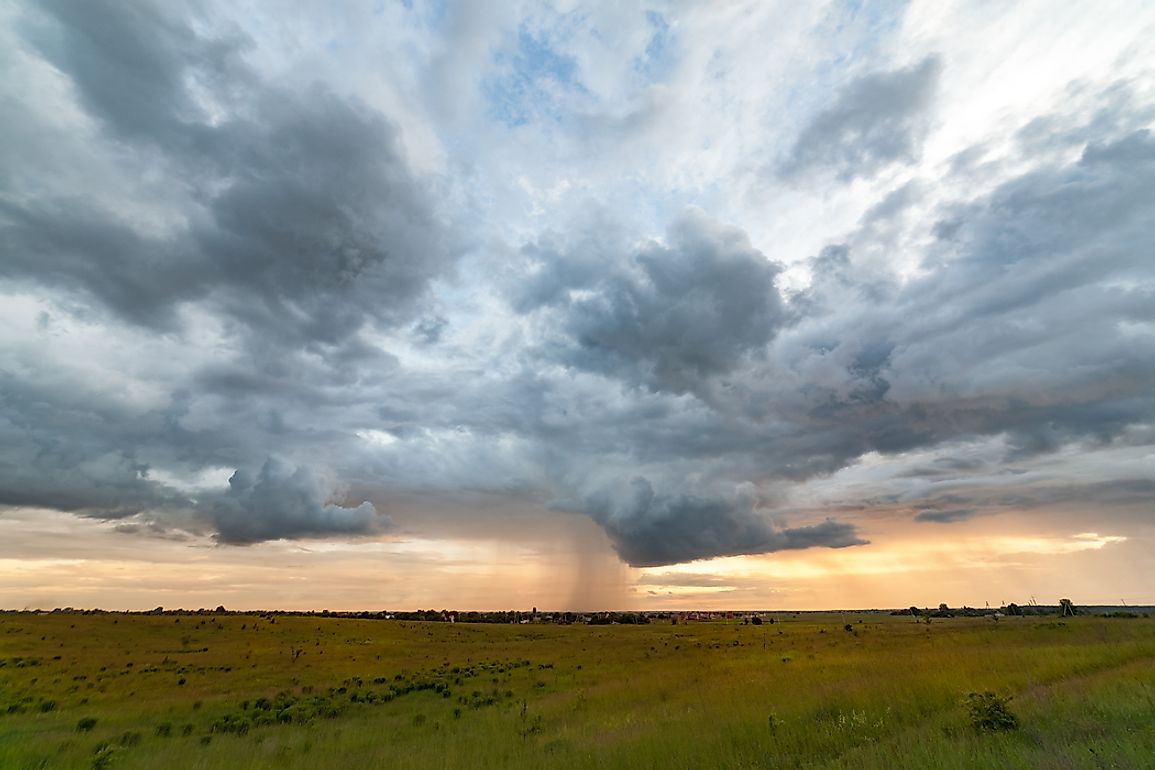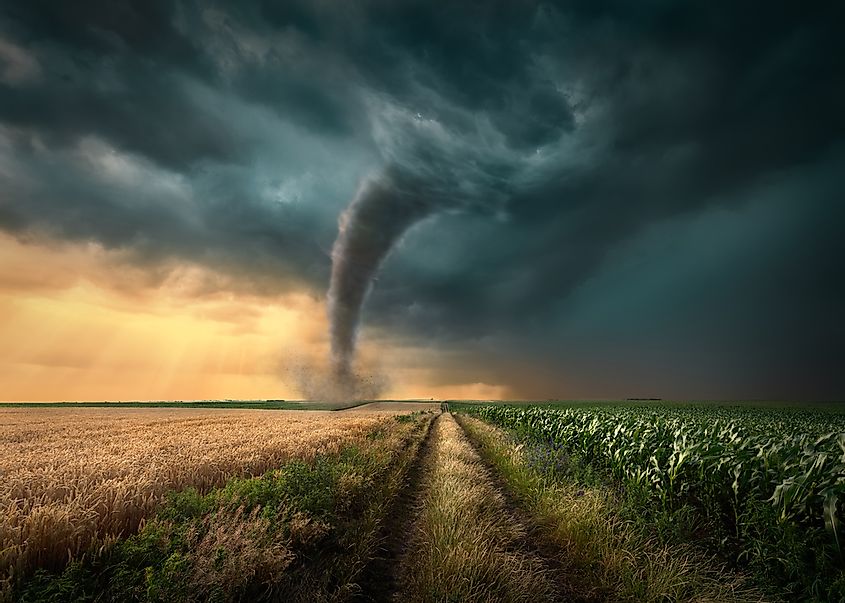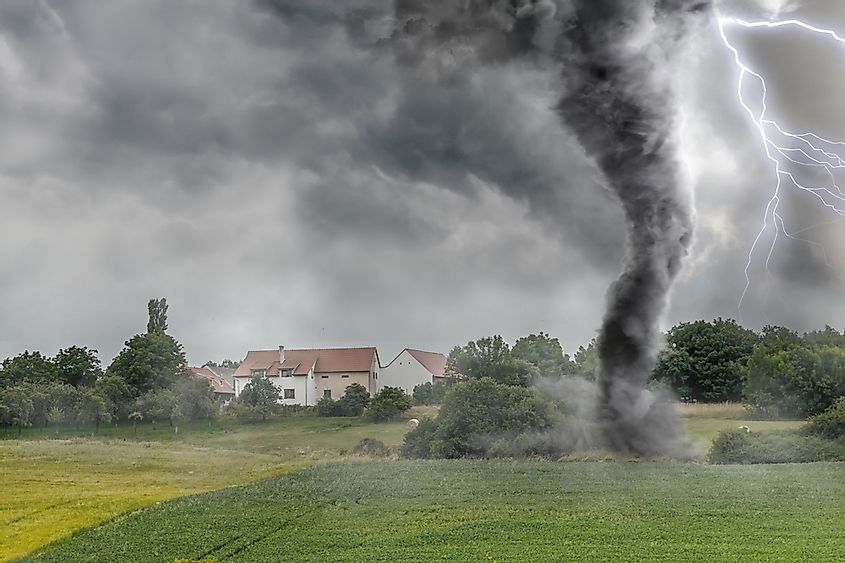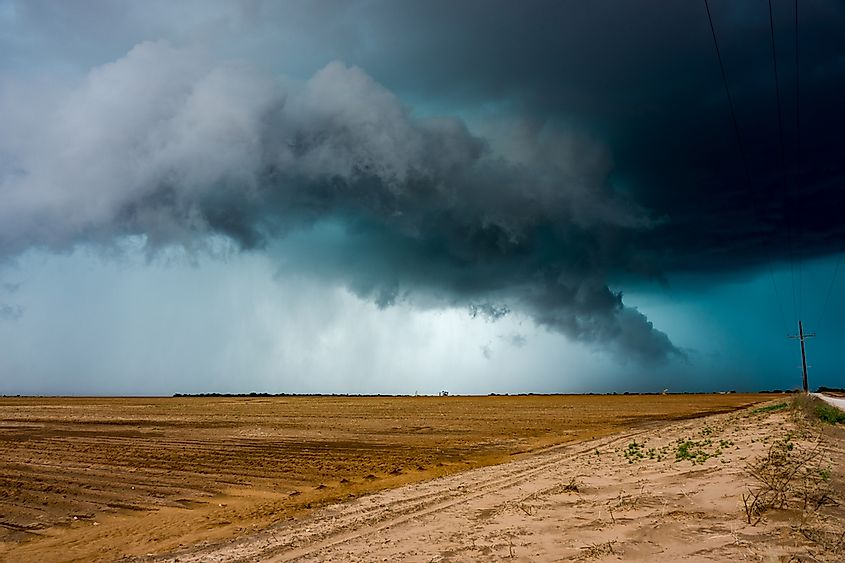Why is Tornado Alley So Prone to Tornadoes?

The entire process happens rapidly.
In a matter of minutes, seemingly tranquil weather transitions to a sky dominated by rotating storms. Heavy rain shrouds the sun and blackens the sky. Hail forming within the storm act as prisms that produce an array of colors, such as turquoise, green or purple. Intense lightning bolts, five times hotter than the sun, emerge from the underbelly of storms complemented by exceedingly loud thunder that rattles windows and deafens ears. Striated clouds, similar to an upside down wedding cake, provide a visual manifestation of a the storm's rotation.
And, then, like a finger emerging toward the ground, a tornado touches down.
What is a Tornado?

A tornado is a center of low pressure that extends from the ground to the cloud base. Similar to a bathtub drain, tornadoes suck air into its center from all directions. The air spins like a whirling vortex, rising into the parent thunderstorm, and up into the sky.
Tornadoes arrive in many sizes, shapes, and intensities. The overwhelming majority – roughly 75% - of tornadoes are weak with winds less than 110 mph (180 kph). However, violent tornadoes, with winds over 200 mph (321 kph), often look wider than they are tall.
Some, in fact, rotate with such ferocity that one often cannot detect any discernable tornadic features. Instead, the supercell essentially descends directly onto the ground. All that can be seen is a black wall of dirt and debris, with flashes emanating from shredded power lines and transformers providing visual clues as to the whereabouts of the strongest vortex.
Violent tornadoes account for less than 2% of the total but they cause 65-70% of all tornado deaths in the U.S. (since 1950).
Where Do Most Tornadoes Occur?
Tornadoes can occur anywhere thunderstorms can occur on a frequent basis, such as Australia, Bangladesh, Canada, Germany, and the United Kingdom, however, most occur in the United States. The United States, has over 1,200 tornadoes per year, enjoys the most prolific supercell and tornadic environment in the world.
Most tornadoes happen in the lengthy tornado season found within the Great Plains region from March until June – the infamous “tornado alley.” In this area, storms are caused when dry cold air moving south from Canada meets warm moist air travelling north from the Gulf of Mexico. Quite often, those tornadoes are large and violent. The U.S. has played host to roughly 600 EF4 (winds exceeding 165 mph / 267 kph) and 60 EF-5 (winds exceeding 200 mph / 322 kph) tornadoes since 1950, far more than anywhere else.
Where is Tornado Alley?
"Tornado alley" is an informal term used to describe areas of the United States (and, in some cases, Canada), where tornadoes are most likely to occur. The states that are generally considered to be a part of tornado alley include Texas, Oklahoma, Kansas, Iowa, South Dakota, Illinois, Missouri, Nebraska, Colorado, North Dakota, and Minnesota. Sometimes, the boundary is increased to encompass Michigan and areas of Southern Canada.
Why is Tornado Alley so Prone to Tornadoes?

The Great Plains exists on the southern end of a continent that stretches from the Arctic to the Tropics. The large landmass acts as highway that transports dense polar air southward. With no southern mountain range, it also allows warm, humidified air from the Gulf of Mexico and Caribbean Sea, uniquely situated to the southeast of the Plains, to proceed unimpeded towards the advancing cold air.
Meanwhile, air arriving from the west of tornado alley originates in the Rocky Mountains. The dry, mountain air slides down the slopes and pushes eastward into the Great Plains, forming what is known as the “dryline.” The air on the west side resembles scorched desert air and often includes large areas of blowing dust. On the east side of the dryline exists ample warm, humid air that reminds one of a swampy coastline.
These are ideal conditions for the storms.
Why are Colliding Air Masses Significant?
- Winds pushing disparate air masses converge in tornado alley. Colliding air, known as fronts, have nowhere to go, therefore they rise.
- Tropical air, when forced upward, encounters naturally cooler air (hence, snow-topped mountains). Like a hot air balloon, the warm air rises freely.
- The collision of air masses occurs several thousand feet in the atmosphere, fuelling a river of high velocity wind that generally moves west to east across tornado alley. This river of air, or jet stream, absorbs rising air from the surface and disperses it downwind like a well-crafted atmospheric engine.
- Sun bakes the ground in the high elevations west of the Plains, notably the flat Colorado Plateau. Westerly winds transport this dry, sunbaked air eastward over the Plains. However, because of the rapid elevation decline, the stable air finds itself approximately 10,000 feet (3,000 meters) high. This suppresses storms until the bubbling air below bursts through at its most explosive point, analogous to a lid blowing off a boiling pot of water.
How do Thunderstorms become Supercells?
The storm’s energetically rising air tilts the horizontal spin into a vertical direction, thus giving rise to a rotating thunderstorm.
What is the Cause of a Tornado?
Despite endless research, tornado scientists still do not understand tornado genesis exceptionally well. The National Severe Storms Laboratory (NSSL) located in Norman, Oklahoma states that field observations link tornadoes to storms that demonstrate strong temperature differences along regions of heavy precipitation. Air in those regions then feed into the storm’s circulation centre.
However, according to NSSL, “Mathematical modeling studies of tornado formation also indicate that it can happen without such temperature patterns; and in fact, very little temperature variation was observed near [the Moore, Oklahoma tornado of] May 3, 1999. We still have lots of work to do.”
Tornado research is no doubt a dangerous business. In 2013, the largest documented tornado – 2.6 miles wide – occurred just outside of El Reno, Oklahoma and took the life of respected scientist and storm chaser, Tim Samaras. His death provided a somber reminder to the danger associated with supercells and tornadoes, even for those who dedicate their lives to understanding them.
Despite the danger, storm chasers and storm researchers sweep into tornado alley each spring on a quest to observe nature’s fury. The extraordinary geographical nuances that encompass tornado alley ostensibly provide storm chasers with their very own thunderstorm playground.
Where do Tornadoes Occur the Most?

NSSL’s location in central Oklahoma is no accident – that is the heart of tornado alley. Recently, the epicenter of the tornado universe appears to be Moore, Oklahoma. Despite its small size (22 square miles), 12 tornadoes have marched through town since 1950, including five significant tornadoes since 1998, and two of them EF-5 with winds over 200 mph (321 kph). Moore’s most devastating tornado occurred on May 3, 1999. With winds over 300 mph (482 kph), the twister flattened the town and killed 42 people. That storm transpired during a week where 152 tornadoes occurred, killing 50 people and causing $1.4 billion dollars of damage.
In fact, Moore’s bad luck continues. Another EF-5 tornado occurred in Moore in 2013, killing 24. Then, this year, on March 25, an EF-2 tornado (winds 111- 135 mph) spun through town along with 2.75-inch diameter hail (7 cm). Fortunately, the most recent tornado spared the lives of those in Moore.
In recent years, many U.S. towns outside Oklahoma have also been leveled by tornadoes, such as Spencer, South Dakota in 1998 (6 fatalities), Greensburg, Kansas in 2007 (11 fatalities), and both Joplin, Missouri and Tuscaloosa-Birmingham, Alabama in 2011 (158 and 64 fatalities, respectively).
Unlike anywhere else, the unique combination of latitudinal position, distinctive topography, and varying air masses provides the United States, notably the Great Plains, with the world’s ripest environment for tornadoes. Similar any good harvest, tornado season arrives each spring and summer in the Great Plains and that is why it reaps the name “tornado alley.”
What States Are in Tornado Alley?
| States in Tornado Alley |
|---|
| Colorado |
| Illinois |
| Iowa |
| Kansas |
| Minnesota |
| Missouri |
| Nebraska |
| North Dakota |
| Oklahoma |
| South Dakota |
| Texas |











